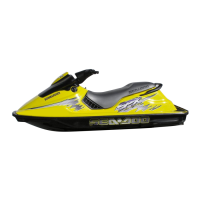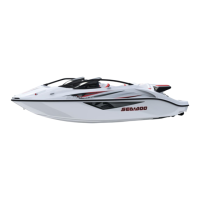SAFETY INFORMATION 17
braking maneuvers in a safe traffic--
free area to become familiar with han-
dling under braking and with stopping
distances under various operating
conditions.
Stopping distance will vary depending
on initial speed, load, wind, number of
riders and water conditions. The
amount of braking power commanded
by the operator using the iBR lever will
also affect stopping distance.
When braking, riders must brace
themselves against the deceleration
force to prevent from moving forward
on the watercraft and losing balance.
When operating an iBR equipped
watercraft, be aware that other boats
following or operating in close proxim-
ity may not be able to stop as quickly.
When at speed and the brake is first
applied, a plume of water will shoot up
in the air behind the watercraft which
may cause the operator of the follow-
ing watercraft to momentarily lose
sight of your PWC. Inform the opera-
tor of a watercraft who intends to fol-
low you in a convoy formation of the
braking capability of your PWC, the
meaning of the plume of water and the
need of keeping a greater distance
between watercraft.
The brake feature of the iBR system
cannot prevent your PWC from drifting
due to current or wind. It has no brak-
ing effect on the rearward velocity. Al-
so note that your engine must be
running to be able to use the brake.
LLeeaarrnniinngg KKeeyy ((iiff EEqquuiippppeedd))
The Sea-Doo LK™ learning key limits
the speed of the watercraft. It could be
an option for first time users and less
experienced operators to learn how to
operate the watercraft.
Please consult your BRP authorized
Sea-Doo dealer to see if this acces-
sory is available for your model.
CCaarrggoo aanndd SSttoorraaggee
Do not store any objects in areas that
are not designed specifically for
storage.
Do not transport cargo on the rear
platform unless it is properly secured
with a BRP LinQ™ certified acces-
sory. Compatible accessories which
are not BRP certified may not be con-
sidered as fit for this purpose.
When carrying loads on the rear plat-
form of the watercraft or onto cargo
accessories, reduce your speed and
adapt your driving behavior to reduce
the risk of ejection from watercraft or
contact with cargo possibly leading to
injuries.
Do not exceed the payload or passen-
ger capacities for your watercraft.
Overloading can affect manoeuvrabil-
ity, stability and performance. Also,
heavy seas reduce capacity.
Never carry loads on the rear platform
when practicing watersports. The car-
go may interfere with the rope and un-
secure it, becoming an obstacle to the
person being towed.
Refer to
Technical Specifications
for
the maximum loading capacity.
AAcccceessssoorriieess aanndd
MMooddiiffiiccaattiioonnss
Any modifications or addition of ac-
cessories approved by BRP may af-
fect the handling of your vehicle. It is
important to take the time to get famili-
ar with the vehicle once modifications
are made to understand how to adapt
your driving behavior accordingly.
Avoid installing equipment not specifi-
cally approved by BRP for the vehicle
and avoid unauthorized modifications.
These modifications and equipment
have not been tested by BRP and
may create hazards. For example,
they could:
GET FAMILIAR WITH THE PWC
